Designing Your Dream Coastal Bedroom: The Ultimate Guide to Choosing the Perfect Color Palette
Creating a truly captivating coastal-inspired bedroom hinges significantly on selecting the right color palette. The serene and soothing atmosphere of a coastal environment is a coveted aesthetic, promising a tranquil escape from the everyday. However, with an almost infinite spectrum of shades and hues available, pinpointing the perfect combination to translate that blissful seaside feeling into your personal sanctuary can often feel like navigating uncharted waters.
The secret lies in embracing colors that are inherently light, airy, and reminiscent of natural coastal elements. Soft blues, reminiscent of clear skies and tranquil seas; sandy beiges, echoing warm shores; and crisp whites, evoking frothy waves and sun-bleached driftwood, are paramount. These hues instantly forge a sense of calm and seamlessly mimic the breathtaking scenery of the coast within your coastal bedroom decor. They transport you to a place where the vast sky gracefully meets the expansive sea, and soft sand gently merges with the shore.
Beyond color, incorporating natural textures plays a vital role in completing the coastal narrative. Materials like woven rattan, rugged driftwood, or earthy seagrass not only enhance the authentic seaside vibe but also introduce a tactile dimension, grounding the space and bringing the raw beauty of nature indoors. This holistic approach, blending thoughtful color choices with organic textures, is the foundation for a truly immersive coastal retreat.
Choosing the Perfect Color Palette for a Serene Coastal Vibe
The foundation of any successful coastal bedroom design is its color palette. These aren’t just colors; they are feelings, memories, and aspirations. Getting them right is essential to creating a space that feels like a permanent vacation.
1. Look to Nature for Endless Inspiration
One of the most effective and organic ways to curate a coastal-inspired color palette is to draw direct inspiration from the natural world around the seaside. The dynamic landscape of the coast offers a boundless array of colors, from the vibrant blue of the endless sky to the gentle greens of coastal foliage and the warm, inviting tones of sandy beaches. Each element provides a clue to creating an authentic and calming environment. Some of the most popular and evocative coastal hues include:
- Cool Blues: These versatile shades are the undisputed champions of coastal design, representing the vastness of the ocean and the clarity of water. They range from the delicate, almost translucent tones of light aqua, reflecting shallow tropical waters, to the deep, majestic navy blue, embodying the profound depths of the open sea. Blues evoke feelings of peace, serenity, and boundless possibility, making them perfect for creating a restful atmosphere. Consider shades like seafoam, robin’s egg blue, or even a muted slate blue to capture different facets of the marine environment.
- Soft Whites: More than just a neutral, white is a powerful symbol of purity, simplicity, and expansive light in a coastal setting. It instantly conjures images of frothy waves crashing against the shore, sun-bleached seashells, and crisp, billowing sails. Used as a primary wall color or for bedding, soft whites create an airy, open feel, allowing the room to breathe and reflecting natural light beautifully. Creamy off-whites or chalky whites can add warmth without losing that essential freshness.
- Earthy Tans and Beiges: These warm, neutral tones are crucial for grounding the coastal palette. They beautifully mimic the natural textures and colors of sand dunes, warm driftwood, and sun-baked shells. Tans and beiges add a comforting warmth and organic feel, preventing the room from feeling too cool or sterile. From light oat to deeper khaki or even a hint of terracotta, these shades offer a subtle richness and a sense of natural stability.
- Light Greens: Often overlooked, light shades of green are integral to capturing the full essence of a vibrant coastal ecosystem. They bring to mind the lush seaside plants, swaying grasses, and verdant marshlands that thrive along the shore. Soft sage, seafoam green, or a pale celery green can introduce a refreshing, organic touch, complementing blues and whites beautifully and adding another layer of natural tranquility to your bedroom.
By observing these natural elements, you can build a palette that truly resonates with the beauty and calm of the coast, ensuring your bedroom feels like a genuine extension of the seaside.
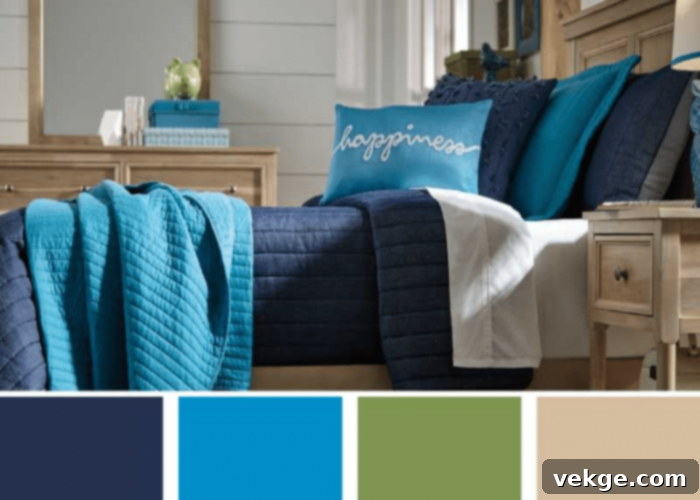
2. Identify a Strong Base Color
The base color is the bedrock upon which your entire coastal bedroom design rests. It establishes the foundational mood and ensures a harmonious space where all decorative elements, from furniture to accessories, come together seamlessly. Begin your color journey by selecting one principal shade that will serve as your base before introducing other hues to your palette. This primary color will dominate your walls or large furniture pieces, setting the overall tone.
For those aspiring to a deeply peaceful and restorative atmosphere, opting for soft blues or muted greens is an excellent choice. These colors inherently possess soothing qualities, creating a restful and serene ambiance that promotes relaxation. A gentle sky blue can make the room feel expansive and open, while a pale seafoam green can bring a refreshing, organic tranquility. Alternatively, if your vision leans towards an inviting warmth reminiscent of charming beachfront cottages or sun-drenched beach houses, earthy tans or beiges make perfect base colors. These neutrals provide a cozy, grounding effect, offering a comforting backdrop that feels both sophisticated and welcoming. They allow other coastal elements to pop without competing for attention, creating a balanced and naturally elegant aesthetic.
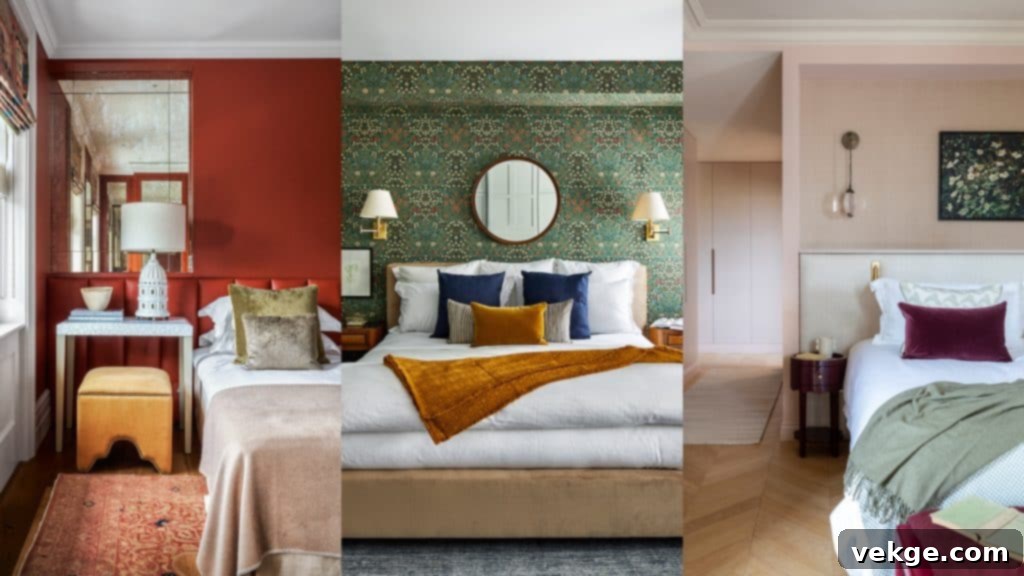
3. Select Complementary Colors Thoughtfully
Once your base color is firmly established, the next crucial step is to introduce complementary hues that will enrich your room’s aesthetic while remaining steadfastly true to its coastal theme. The goal here is to create visual depth and sustained interest without overwhelming the serene quality of the base. To achieve this, resist the temptation of a purely monochromatic scheme. While a single-color palette can be elegant, it often lacks the dynamic texture and visual story that a well-curated coastal space demands.
Instead, introduce variety by mixing diverse tones within the same color family, or by selecting analogous colors that sit next to each other on the color wheel. For instance, if your base is a soft blue, consider layering in deeper blues, muted grays, or even a whisper of green. When combining colors, a key principle is that coordinating colors should never overpower your chosen base color; they should support and enhance it. For example, if you’re pairing a vibrant seafoam green with a rich navy blue, ensure that the navy is used judiciously—perhaps on an accent wall, throw pillows, or a piece of furniture—to prevent it from dominating and diminishing the calming, expansive effect of the lighter green. The aim is a harmonious blend where each color plays its part, contributing to a cohesive and subtly layered coastal experience.
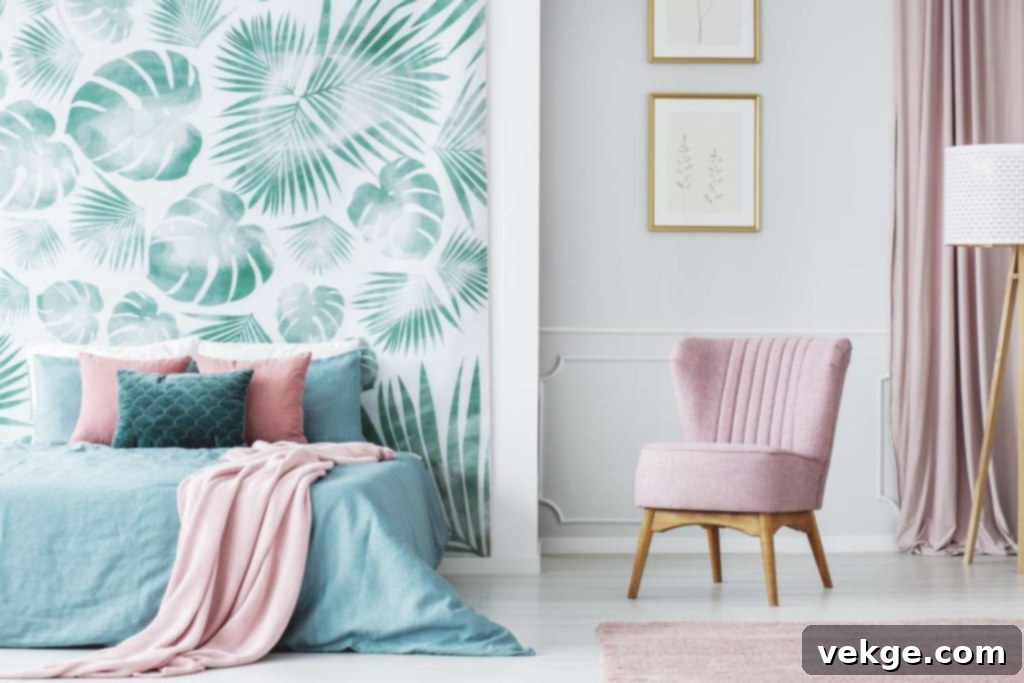
4. Incorporate Vibrant Accent Colors
Accent colors are the sparks that ignite energy and personality within your coastal bedroom, effectively breaking up any potential monotony in your core palette. These splashes of color serve a dual purpose: they can highlight prominent architectural features or key design elements, and they can transform smaller decor pieces into focal points. Think throw pillows, unique artwork, a striking rug, or a decorative vase.
When choosing accent colors for a coastal scheme, consider hues that offer a dynamic and visually appealing contrast. Exploring complementary colors—those directly opposite on the color wheel—can yield stunning results. For example, against a backdrop of soft blues and sandy neutrals, bold accent colors like vibrant coral, deep teal, sunny yellow (reminiscent of a beach umbrella), or even a rich terracotta (like a specific type of seashell or rock) can create breathtaking visual interest. These vibrant pops inject a splash of life and energy, adding a contemporary twist while still faithfully exuding the timeless charm and natural beauty of the coast. The key is strategic placement and moderation to ensure they enhance, rather than overwhelm, the overall serene atmosphere.
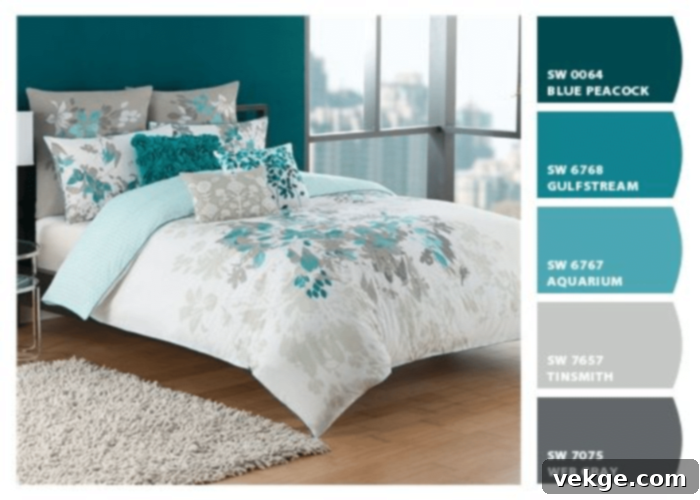
5. Diligently Test Your Color Choices
Before making a final commitment to any color palette, especially for a space as personal as a bedroom, it is absolutely paramount to test your chosen shades within your specific environment. This crucial step can save you from costly mistakes and ensure that the colors you select truly perform as anticipated.
Begin by purchasing small paint samples or gathering fabric swatches for your intended hues. Place these samples in various areas of your room – near windows, in darker corners, on different walls, and next to existing furniture or flooring. Observe how these colors interact with both natural and artificial light throughout the day and into the evening. A color that looks perfect under bright morning sun might appear dull or entirely different under soft lamp light or on a cloudy afternoon. Additionally, take note of how the colors make you feel. Do they evoke the desired sense of calm, joy, or relaxation? Do they align with the overall mood and atmosphere you envision for your coastal retreat?
Remember that factors such as the amount of natural light, the direction your room faces, and the colors of your existing flooring and furniture can significantly alter the appearance of any paint color. Live with these samples for a few days, if possible, to truly understand their subtle shifts and ensure they create the harmonious coastal sanctuary you dream of.
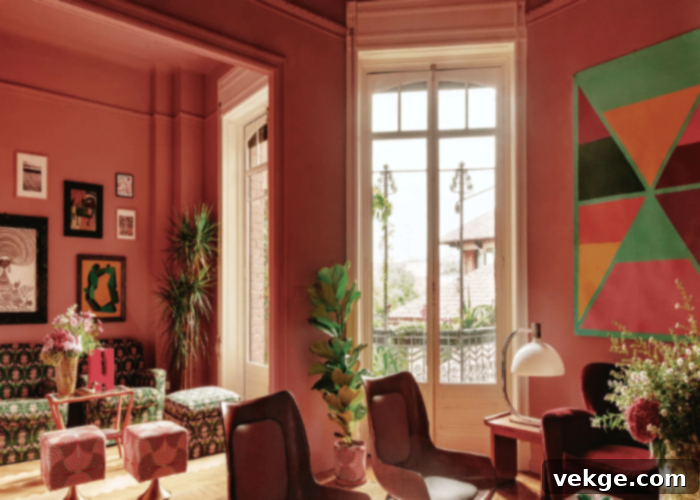
6. Master the Balance of Color Weight
Achieving a cohesive and inviting coastal-inspired bedroom design relies heavily on mastering the balance of color weight throughout the space. “Color weight” refers to the visual impact and perceived dominance of different colors. The objective is to create equilibrium, preventing any single color from overwhelming the room and disrupting the intended serenity.
To cultivate that desired tranquil, coastal atmosphere, avoid the temptation to overload the room with an excessive number of bold or overly vibrant colors. Instead, adopt a more nuanced approach. Focus on a foundation of calming neutrals such as soft whites, creams, and sandy beiges, which will make up the majority of your palette. Layer these with gentle pastels, particularly soft blues and greens, reminiscent of the ocean and sky. These lighter, airier shades contribute to the expansive and refreshing feel. Finally, introduce judicious pops of deeper, ocean-inspired blues and greens as accents. This balanced distribution—a larger proportion of neutrals and pastels, with smaller, strategic doses of richer hues—will effectively create a soothing and serene ambiance that truly evokes the peaceful essence of the coast, without feeling chaotic or visually heavy.
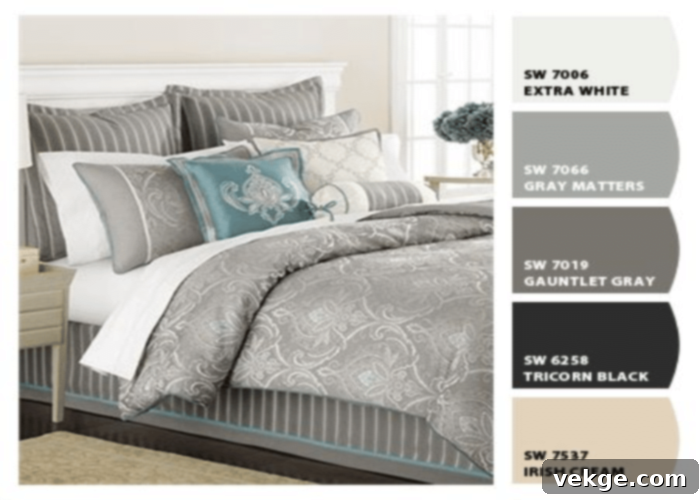
7. Embrace a Minimalistic Approach
The essence of coastal living often evokes a sense of freedom, simplicity, and uncluttered spaces. To truly capture this, embrace a minimalistic approach in your bedroom design. This doesn’t mean the room needs to be stark or empty; rather, it implies a deliberate focus on intentionality and quality over quantity when it comes to decorative items.
Avoid the common pitfall of overcrowding the space with too many accessories or pieces of furniture. Instead, meticulously select a few key statement pieces that genuinely evoke the coastal theme. Consider a beautifully weathered piece of driftwood, a collection of unique seashells thoughtfully displayed, or an elegant framed print of a seascape. By limiting visual clutter, you allow the room to feel more open, airy, and expansive, directly enhancing the overall tranquility and sense of calm that is synonymous with the coast. Opt for a functional yet aesthetic approach: perhaps a striking driftwood mirror above a simple dresser, or a lamp with a base shaped like a natural shell. These carefully chosen items add significant coastal flair and personality without detracting from the peaceful, spacious atmosphere you’re striving to create.
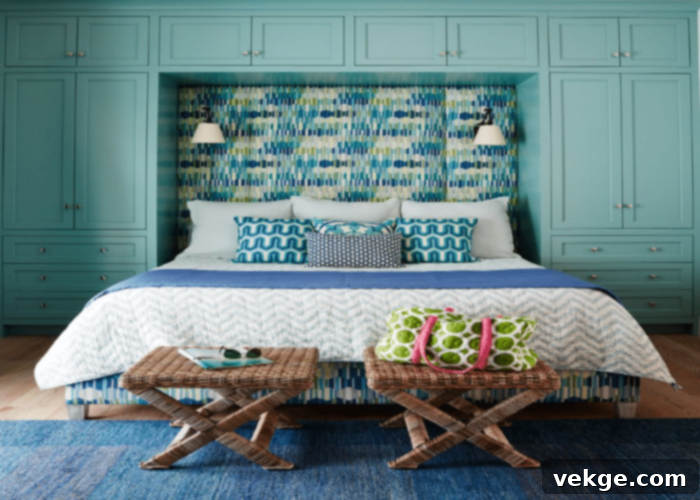
8. Thoughtfully Consider Artwork and Accessories
Artwork and accessories are the finishing touches that breathe life into your coastal bedroom and deepen its thematic connection to the seaside. These elements act as storytellers, reinforcing the chosen aesthetic and adding layers of personality and charm.
Elevate the room’s overall vibe by hanging beach-themed artwork that evokes the beauty of the ocean. Think serene seascapes depicting calm waters, vibrant coastal landscapes showcasing dunes and lighthouses, or even abstract pieces that mimic the movement and colors of waves. In addition to wall art, thoughtfully incorporate accessories that speak to the coastal theme. Woven baskets made from natural fibers like seagrass or rattan can add texture and provide practical storage. Glass jars, filled with a curated collection of seashells, sea glass, or smooth pebbles, serve as elegant and personalized decorative accents. These small yet significant touches add immense depth and character to the space, crafting a cohesive, visually appealing, and wonderfully relaxing atmosphere. Further enhance the theme by displaying framed photos of cherished beach memories, a collection of intriguing beach-themed books, or sculptural elements like coral pieces on shelves or side tables, ensuring every detail contributes to your tranquil coastal sanctuary.
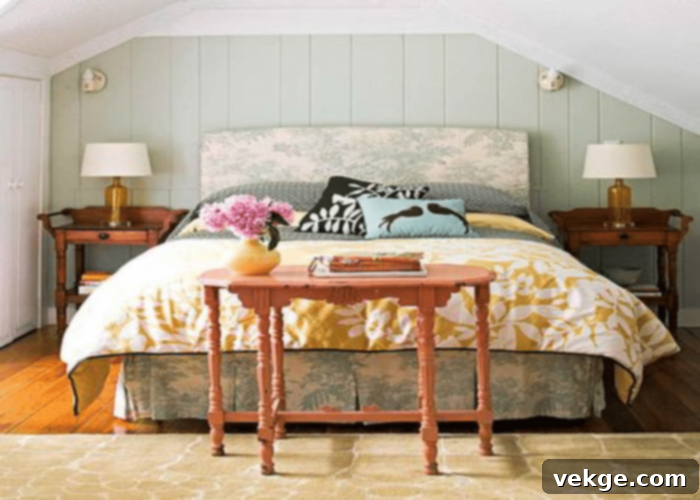
9. Layer Your Coastal Color Scheme
Once you’ve chosen your base, complementary, and accent colors, the art lies in effectively layering them throughout the various elements of your bedroom to create a cohesive and immersive coastal experience. This involves more than just selecting colors; it’s about strategically applying them to different surfaces and textures to build depth and interest.
Begin by painting the walls in soft, soothing shades like light blues, crisp whites, or sandy neutrals to establish the primary beachy feel. These foundational colors create a backdrop of calm and spaciousness. Next, consider how to incorporate pops of more vibrant colors, such as coral or turquoise, which beautifully mimic the breathtaking hues found in beach sunsets, exotic tropical fish, or vibrant coral reefs. These can be introduced through textiles like throw blankets, decorative pillows, or smaller art pieces. Furthermore, choose textiles and fabrics with beach-inspired patterns; think classic stripes (especially navy and white for a nautical touch), subtle wave motifs, or even delicate shell patterns to further enhance the coastal aesthetic. If you’re feeling adventurous, consider a patterned wallpaper featuring subtle coastal motifs on an accent wall. The key to layering is ensuring a harmonious flow, where each element contributes to the overall serene, beach-inspired narrative without overpowering another.
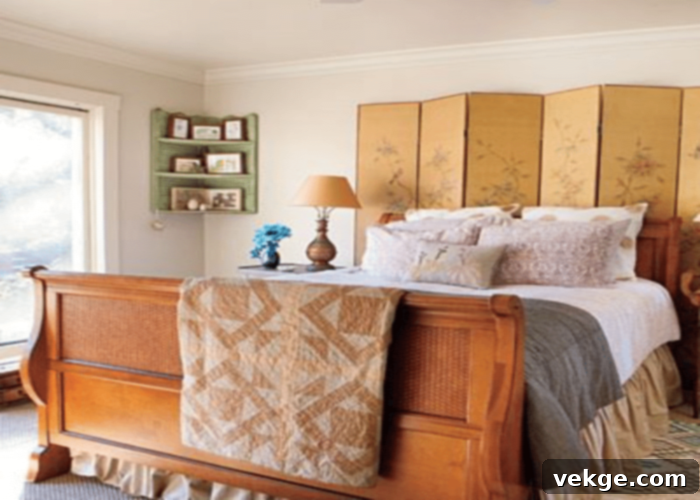
10. Incorporate Abundant Natural Materials
A crucial element in solidifying the coastal aesthetic and creating an authentically relaxed and organic feel is the thoughtful incorporation of natural materials. These elements act as a tangible link to the outdoors, grounding your bedroom in the genuine textures and forms found along the shore.
Consider furniture crafted from light-toned, natural woods, bamboo, or rattan. These materials not only add a touch of handcrafted authenticity to the coastal theme but also introduce beautiful textures and warmth that are inherently relaxing. A rattan headboard, a bamboo bench, or a light-washed wooden nightstand can instantly transform the space. Beyond furniture, add texture to the space through a variety of textiles and decorative items: think soft, breathable linen curtains that billow gently, cozy jute rugs underfoot that evoke sandy pathways, or chunky woven baskets for stylish storage. Further enhance these natural elements with small, tactile accents such such as real seashells collected from the beach, artfully arranged pieces of weathered driftwood, or smooth river stones. These choices create a multi-sensory experience, making your bedroom not just look coastal, but feel deeply connected to the natural, tranquil beauty of the seaside.
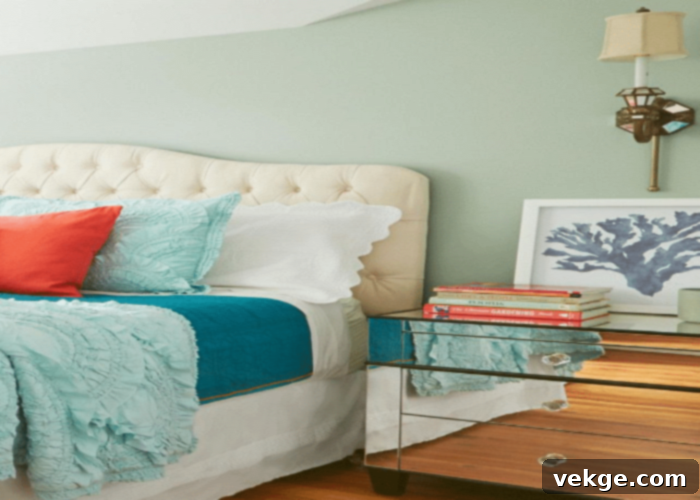
Conclusion: Crafting Your Perfect Coastal Retreat
Choosing a color palette that perfectly embodies the coastal vibe in your bedroom is an art form that transforms a simple room into a personal sanctuary. The essence lies in a deliberate focus on incorporating soothing, natural colors directly inspired by the sea, the sky, and the sand. By opting for a foundation of soft blues, tranquil greens, and grounding neutrals, you effortlessly lay the groundwork for a peaceful and incredibly inviting atmosphere that promotes relaxation and rejuvenation.
Furthermore, do not shy away from the opportunity to experiment with carefully placed pops of bolder, yet still coastal-inspired, colors or patterns for accent pieces. A vibrant coral pillow, a striking teal throw, or a nautical-striped rug can provide that perfect balance of tranquility and compelling visual interest. By thoughtfully selecting and strategically layering a cohesive color palette, combined with the tactile warmth of natural materials, you will effortlessly bring the deeply relaxing and invigorating essence of the coast directly into the heart of your bedroom. This thoughtful approach ensures your personal space becomes a timeless haven, echoing the endless beauty and calm of the seaside.
